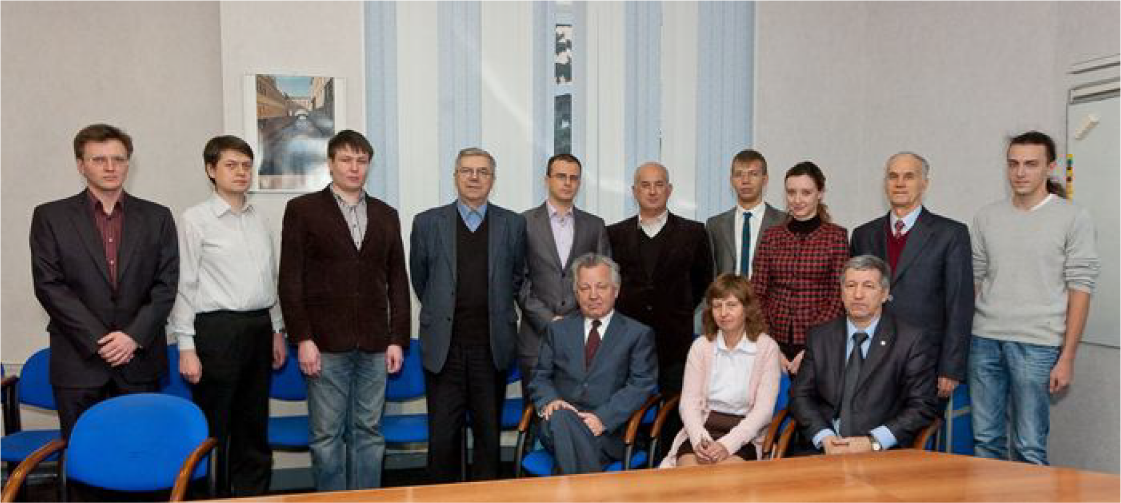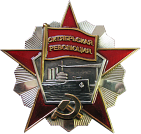The building of the Military Topographic Department of the General Staff Main Office is founded at the intersection of Malaya Posadskaya and Bolshaya Wulfova streets in Saint Petersburg.
On September 8, 2016, during the reconstruction of the oldest building, a memory plate of 1916 was found in one of the rooms on the first floor of the Round Tower; it was placed there during the construction of the building foundation. The plate stayed in the wall for hundred years.
The inscription on the plate reads:
"On July 8, in year 1916 A.D., during the reign of His Imperial Majesty the Sovereign Emperor Nicholas II, when the Military Minister was General of Infantry D. S. Shuvaev, the Head of the General Staff was General of Infantry M. A. Belyaev, and the Head of the Military Topographic Department was General of Infantry I. I. Pomerantsev, this building of the Military Topographic Department of the General Staff Main Office was founded, with participation of the Military Construction Committee: the Chair, General of Infantry I. I. Pomerantsev;
Members: Major General N.A. Medzvetskiy, Major General V. I. Podyapolskiy, Captain A. N. Ivanin, Collegial Assessor A. P. Vasilyev, Clerk, Colonel G. T. Ivanishchev, and Civil Construction Engineer N.I. Drozdov;
in presence of the State Control representative, Junior Inspector A.G. Smirnov”.
The memorial plate was placed in the museum of our enterprise; it became another symbol of glorious history of the Institute and respectful care for our traditions.
By the decision of the Soviet Labor and Defense Council, the unfinished building in Malaya Posadskaya street was transferred to the Plant of Electrical Metering Devices.
On November 19, 1927, the construction and outfitting of the first building of the Plant of Electrical Metering Devices "Elektropribor" in Malaya Posadskaya street was completed. A month before, in October 1927, the Plant started the production.
Pursuant to the Decision of the Central Committee of the Communist Party and the Council of People’s Commissars of 17 March, 1928, the naval department was created within the Elektropribor Plant. The plant is defined as the main developer of ship artillery fire control systems.
The scientific and technical library was opened at the plant; and its own educational units were created.
The first fire control devices (АСВ) are delivered to the naval onshore batteries.
The first anti-aircraft fire control devices, guidance devices for flying aircraft searchlight and sound-catching detection systems were developed.
Vocational schools are being opened to train qualified workers required for the plant. The Plant Electrotechnical College was opened in the building of Petrovsky College (now Nakhimov Naval School).
A group of the Naval Department engineers under the leadership of N. N. Ostryakov started to create the country's first gyroscopic devices. Assistants of N. N.Ostryakov were young engineers S. F. Farmakovskiy and V. I. Kuznetsov. Academician A. N. Krylov, Professors B. I. Kudrevich and S. A. Izenbek, as well as engineer-colonel G. V. Chekhovich were engaged by the Plant as scientific consultants.
The naval coastal batteries started receiving the Barricade fire control systems with horizontal-base range-finder (head of design team — S. F. Farmakovskiy).
The Leningrad Institute of Precision Mechanics and Optics opened a new department meeting the profile of the enterprise (now INS Department of ITMO University).
The first Soviet gyroscopic bomb sight (head of design team: engineer V. M. Gribov) and the first autopilot were developed, soon transferred to other plants for manufacture.
Dedicated Department was opened at the Leningrad Electrotechnical Institute (LETI)
The first Soviet serial gyrocompass Kurs was created (head of design team: N. N. Ostryakov).
The first Soviet serial vertical gyro Shar was developed based on the gyroscope with gas-supported steel spherical rotor.
Gyrocompasses and vertical gyros started to be supplied on warships.
Fire control systems for shipborne main caliber artillery were supplied to the Navy, on the battleships "Marat", "Paris Commune", "October Revolution", the cruiser "Red Caucasus" and the destroyer "Kalinin”.
World War II.
The Plant launched the production for the front and provided operation and repair of the equipment previously supplied to the ships.
Part of the plant was evacuated to Moscow where the Special Design Bureau of Shipbuilding Industry was created (chief engineer S. F. Farmakovskiy), and part was moved to Sverdlovsk where the Precision Mechanics Plant was organized.
The team of the Naval Department specialists, headed by N. N. Ostryakov, were awarded the Stalin Prize (later called the State Prize) for developing the first Soviet vertical gyro Shar.
The first Soviet serial small gyrocompass Girya was created for use on naval and commercial ships.
Periodic scientific and production bulletin Priborostroeniye (Instrument-Making) (now the Gyroscopy and Navigation journal) was established. S.F. Farmakovskiy was the Editor-in-Chief till 1983, and since then this position has been taken by V. G. Peshekhonov.
On the initiative of V. M. Gribov and S. F. Farmakovskiy who returned from Moscow, the Leningrad Branch of the Moscow Special Design Bureau of the People's Commissariat of Shipbuilding Industry was established at the plant.
For the development of the first Soviet gyrocompasses N. N.Ostryakov was awarded the Stalin Prize.
The first Soviet dead reckoning tracer Put’ (chief designer A. A. Lisitsyn) was put into service, which provided automated solving of dead reckoning problems for navigation, saving the ship’s current position data, and geographical display of the ship’s way on navigation map.
The branch of the Moscow Special Design Bureau of the People's Commissariat of Shipbuilding Industry was transformed into an independent research institute NII-303.
High-performance fire control systems Molniya and Zenit were developed. They were for the first time equipped with automatic fire director TsAS-U which did not have world analogs. The fire director provided automated solutions for firing coastal, sea and air targets. Also, the fire control system included a coordinate converter PKU (S.F. Farmakovskiy was the author of the idea and performed general supervision of the project).
Post-graduate department was founded at the research institute to intensify the research personnel training.
Academic Council has been organized at the Institute, headed by the Council Chairman V.M. Gribov and Deputy Chairman S. F. Farmakovskiy, to perform the research personnel training management.
According to the Resolution No. 4098-1616 of the USSR Council of Ministers, dated 09 September, 1952, the NII-303 became one of the main developers of equipment for the first Soviet nuclear submarine. The Institute started the development of integrated navigation systems for submarines.
Gyrostabilization systems C-3 and C-3M on open ball gyroscopes were developed; chief engineer S.F. Farmakovskiy was in charge of development.
The first conference of young specialists (held at the Institute until 1985) was held. Later, from 1999, it was resumed as the Conference of Young Scientists.
Integrated navigation system Sila-N was created for the first Soviet nuclear submarine of 627 project (chief designer V. I. Maslevskiy).
The Institute started work on a fundamentally new all-weather astronomical means of maritime navigation, radio astrooptical correction systems, or radiosextants (chief designer M. K. Petushkov).
The first scientific and technical conference in memory of outstanding scientist and engineer N. N. Ostryakov was organized at CSRI Elektropribor, which has been held biennially since then.
Elektropribor Plant was affiliated to NII-303 as a pilot-production plant no. 212.
Construction of the Institute’s testing facilities started on the shore of the Ladoga Lake (Cape Cheremukhin).
Gyrostabilization systems Grot and Baza were developed (chief designer A. I. Smirnov).
The nuclear submarine K-3 Leninskiy Komsomol with the navigation system Sila-N (chief designer V. I. Maslevskiy) reached the North Pole for the first time in the history of Russian Submarine Fleet.
All-latitude navigation system Sigma (chief designer V. I. Maslevskiy) started to be supplied to nuclear submarines of various projects.
The Institute was awarded the Order of the Red Banner of Labor The title of the Lenin Prize laureates was awarded to chief designer of the NS Sigma, the head of Submarine Navigation Department Valentin Maslevskiy, chief designer of vertical gyro Alexander Kogan, chief designer of ball gyros Gennadiy Malyshev, chief technologist of gyroscopic equipment Mikhail Pakhomov, one of the main designers of the navigation system Yulii Rikhterman, chief engineer and First Deputy Director of the Institute Sergey Farmakovskiy, and the Navy representative Valerian Dukalskiy.
Fire control systems Dozor-1 and Dozor-2 were developed for the escort ships, and fire control system Drakon for small anti-submarine ships (chief designer L. Ya. Polyak). L.Ya. Polyak was awarded the Lenin Prize for the fire control systems development.
The Institute started developing the first Soviet serial high-precision orientation system for telescope on the Earth remote sensing spacecraft, gyroorbitant Kvant (chief designer V. G. Gordeev).
The first line of the Research Institute branch (scientific and technological complex for gyroscopic equipment production) was put into operation in Gatchina, Leningrad Region.
The enterprise was renamed to the Central Scientific Research Institute “Elektropribor”.
Work started on the development of an uncontrolled electrostatic gyroscope (ESG) (chief designer A. S. Afinogenov).
Gyroscopic guidance system Luch was developed for mine rocket launchers (chief designer V.M. Gribov).
The development of a new type of navigation devices — radio Doppler logs RDL-1 (later - RDL-2, RDL-3) started (chief designer Yu. P. Kharitonov).
The first Soviet high-precision gyroscopic sensing element was created: a ball gyroscope with aerodynamic support of rotor (chief designer P. I. Vorobiev, later O. L. Mumin). For the first time the aerodynamic gyroscope was constructed with reverse circuit; it had closed structure and thermal stabilization system.
According to the Resolution of the USSR Government, CSRI Elektropribor was assigned to develop inertial navigation systems Medveditsa for general purpose submarines, and Simfoniya for strategic missile nuclear submarines (chief designers V. G. Gordeev till 1973, and V.G. Peshekhonov from 1973).
CSRI Elektropribor was made a head company within the Leningrad Scientific and Production Association “Azimut”.
The Institute started development and production of traditional marine navigation equipment, such as magnetic compasses, logs, and echo sounders.
Marine gravimetric system Cheta-AGG was developed (chief designer A.D. Bereza). Scientific support to this and some other advanced developments was provided by the classic of national gyroscopy, Doctor of engineering sciences, Professor S. S. Rivkin.
Navigation system Briz-N was created and put into mass production for large-tonnage sea vessels. Chief designer Ya.G. Ostromukhov was awarded the State Prize of the USSR for Briz-N system development and implementation
INS Strelets was developed on the basis of closed inverted ball gyro with aerodynamic support of rotor. It was further developed into INS Stellit (chief designer B. D. Zharkov).
Gyrostabilization systems Nadir and Ladoga were developed and put into service in the Navy (chief designer I.M. Okon).
Automated motion control system Smena-4 was developed for amphibious ground effect vehicles of Orlenok type (chief designer V. B. Diomidov).
A unique inertial corrector Scandiy based on ESG was created (chief designer V. Z. Gusinskiy).
The first prototype of the NC Simfoniya was installed on the lead nuclear-powered attack submarine, project 941.
State tests of Medveditsa navigation system on the submarine K-524 were completed with under-ice cruise to the High Arctic. On 24 March, 1980, the submarine carried out surfacing at the North Pole. The technical supervisor of the NS tests during the cruise was its chief designer V. G. Peshekhonov.
Tests of the navigation complex Andromeda-1101 on the lead heavy nuclear-powered guided-missile cruiser of 1444 project were completed (chief designer V. G. Peshekhonov).
As part of the production conversion program, the company starts developing and manufacturing hi-tech non-military products such as medical equipment: cardio-and pulmonological monitoring systems, joint implants, dental devices for occlusion registration, plates and screws for osteosynthesis in maxillofacial surgery, etc. (project manager N. K. Lyubomirova).
Testing of the navigation system Simfoniya were completed; new guided missile system testing was supported. The NS Simfoniya was approved for use in the Navy.
The company was awarded the Order of October Revolution.
The Lenin Prize was awarded to the chief designer of the navigation complex Simfoniya V. G. Peshekhonov. State Prizes were awarded to chief designer of ESG A. S. Anfinogenov and chief designer of inertial corrector V. Z. Gusinskiy. A large group of the Institute employees were awarded orders and medals.
The NS Simfoniya started to be supplied in reduced complete sets to general nuclear submarines.
Navigation complex Simfoniya was successfully operated during the cruise of the lead nuclear-powered attack submarine of 941 project (Shark) to the North Pole.
Automated motion control system Smena-3 was delivered for missile strike ground-effect vehicle Lun’. The chief designer V. B. Diomidov was awarded the State Prize of the USSR for creating and implementing the automated motion control systems for ground effect vehicles.
Based on the hardware of the NS Simfoniya, the NS Andromeda was developed for use on special surface ships (chief designer V. G. Peshekhonov).
For small-size missile sidewall craft (project 1239 Sivuch), a small-sized navigation system Pritok was developed (chief designer O. V. Perepelitsyn).
Production of windmills UVE-40 for the national economic purposes was launched. Later, the models UVE-200, UVE-300 and UVE-500 were also developed (development supervisors N.A. Muzyka and Yu. A. Muzyka).
CSRI Elektropribor became an independent state enterprise again after the Leningrad Scientific and Production Association "Azimut" had been dissolved.
The Institute got the status of the State Research Center of the Russian Federation.
Pilot-production plant “Azimut-Elektropribor” was incorporated in the Institute structure.
The Institute got the title of State (Federal State since 1999) Unitary Enterprise "CSRI Elektropribor”.
FSUE CSRI Elektropribor was joined by the State Unitary Enterprise “KB SvyazMorProekt” (Design Bureau) as the engineering center (EC “KB SvyazMorProekt") with a branch in Lebyazhye town (Branch No. 2).
On the premises of the Design Bureau of Informatics, Hydroacoustics and Communication of the FSUE "NPP "Volna", Branch No. 3 was established in Moscow.
Decree No. 400 of the President of the Russian Federation issued on 21 March, 2007, established an open joint-stock company “OAO “Concern CSRI Elektropribor” ("Concern CSRI Elektropribor” JSC, since 2015)
Altai Instrument-Making Plant “Rotor” (Barnaul city) entered the Concern.
“Pribor” Plant (Chelyabinsk) and Caspian Plant of Precision Mechanics (Kaspiysk, Dagestan Republic) entered the Concern pursuant the Decree No. 272 of the President of the Russian Federation dated 28 May, 2015.






